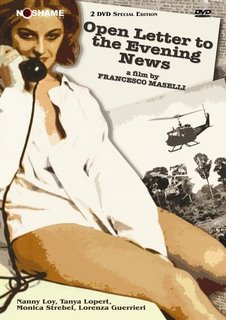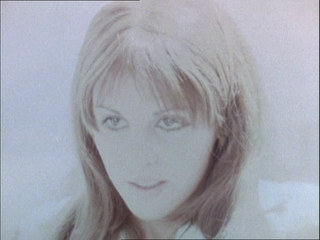Movie Reviews That'll Put Yer Eye Out, Kid!

Trilogy of Terror (1975)
After watching this 70s made-for-T.V. movie, you will come away with this starry gem: nothing is as it seems. That's right - just as this innocuous review is actually a rousing critique of society, and peanut butter is really where grandma went after her "long rest" - nothing is what you'd expect it to be. Unless, of course, you've seen enough movies to know that "nothing is as it seems" is a pretty reliable plot twist, and you're just waiting for it to happen.
Enter Trilogy of Terror, where the unexpected is their specialty...or their ketchup. Featuring three short films based on Richard Matheson tales rolled up into one seventy-nine minute burrito of thrills, the Trilogy stars the inimitable (and purportedly difficult to work with) Karen Black. The first set-up, entitled "Julia," places Ms. Black as a dowdy professor embroiled in a studly student's obsessive sexual goals. Will the professor find a way out of her naughty student's games, or will she merely give him an "A" at the end of the quarter? The second short flick, "Milicent and Therese," has Ms. Black working overtime as both sisters Milicent and Therese. When the their father dies, good girl Milicent decides to stand up to her Satan-worshipping, good-time sister Therese once and for all. After warning off Therese's boyfriend about Therese's wicked ways, Milicent next attempts other, harsher means (Satan comes into this) to get rid of the bitch...against the local doctor's orders. Lastly, we have "Amelia," which pits Karen Black against a birthday present she bought for her boyfriend. The present, an "innocent-looking" Zuni doll that is supposed to contain the soul of a deceased hunter, proves to be a regular ankle-biter once Amelia opts to spend the night in. The lesson being: always go out on a Friday night, of course!
"Julia" and "Amelia" are the most interesting of the three tales - if only due to the fact that they contain sexual blackmail and violent figurines. Ms. Black's acting is believable, and the stories are easy enough to view in a mindless sort of way.
The problem with the tales lies in their predictability, and thematic similarity. While the acting is fairly strong overall, some directorly no-nos make it an agonizing ordeal - especially at one point early on in "Amelia" where Ms. Black interacts with not one, but two actors entirely over the phone - resulting in the monologue that just wouldn't die. "Milicent and Therese" faces the problem of being entirely too long, especially since there is little action, much talking, and the ending is clearly broadcast within the first five minutes of the film or so. The ending, which is supposed to be unexpected, would only be found so if the viewer is exceptionally tucked away from society and film-viewing at large. Perhaps a child raised by hobos, or hideously strict parents with an aversion to "talkies," would be surprised. Personally, I was surprised that a general practitioner was clearly giving psychiatric advice to Milicent. I had no idea that he was so qualified, and I really can't think of anything better than a psychiatrist that takes your blood pressure and gives you a lollipop at the end of the session.
Although most of the films are shot in a very visually straightforward way, some nice cinematographic touches do come into play. In "Julia," a shot of the furious bespectacled professor with flames reflected in her lenses comes off nicely, while in "Milicent and Therese," amid a flurry of annoyingly low angles, comes one brilliant one that seems to put a halo around goody two-shoes Milicent's crown. The musical theme, with stings aplenty, created by Robert Cobert, is also memorable and fun.
This made-for-T.V. movie comes in a very watchable print brought to you by Dark Sky Films. The DVD also comes with a feature-length commentary with Karen Black and writer William F. Nolan, a "Three Colors Black" featurette, and a "Richard Matheson: Terror Scribe" featurette. Both featurettes include horrormeisters Karen Black and Richard Matheson denying that Trilogy of Terror has anything to do with the horror genre, despite evidence to the contrary. Apparently Matheson prefers to be thought of as a Terror writer, and as for Black, she makes herself look terribly silly by claiming that Trilogy of Terror is a work of Science Fiction! Apparently horror is a dirty, dirty, word (perhaps due to the homophone "whore" that matches the first syllable of "horror"), and Black tries hard to come clean from the grime that still, apparently, clings to her soul a la Lady Macbeth.
For fans of the film Dark Sky's release makes a decent upgrade - and for those who haven't seen it - if you've got nothing to do on a Friday night, and want to risk the danger of staying in, you could do worse than watch Trilogy of Terror.
Tweet
Labels: dark sky films, dvd, karen black, review, richard matheson, trilogy of terror
I'll have some advance reviews next, next week (Sept. 28), including a look at Dark Sky's upcoming release for Trilogy of Terror! However, until then feel free to peruse my reviews of these dandy titles.
Slither
The Pinky Violence Collection
The Devil's Sword
Virgins from Hell
La Mala Ordina
Don't Deliver Us from Evil
Slither
The Pinky Violence Collection
The Devil's Sword
Virgins from Hell
La Mala Ordina
Don't Deliver Us from Evil

Open Letter to the Evening News (1970)
A group of friends and colleagues, all of whom belong to Italy's political left, get together for a little ping-pong, a lot of sangria, and ultimately, some fierce ideological debate. A phone call is received and it's announced to minglers and debaters both that a major newspaper has requested the group share its opinion regarding the war in Vietnam. Believing that their radical and dissentious views on the subject won't actually be published, a letter is written in which the leftists volunteer to fight alongside the Vietnamese against U.S. military forces. When, much to their surprise, the letter is published in another newspaper, those who drafted the letter are confronted with their own political beliefs, and must determine if the powerful political reverberations of their words, in reality, are nothing more than a hollowness of intentions.

Director Francesco Maselli's film, Open Letter to the Evening News, reflects not only the political climate in Italy during the time in which it was made, but also holds up a mirror to the beliefs and actions of the extreme political left, which Maselli was, and continues to be, aligned with. The film is both brave and uncompromising in its scrutiny of political beliefs (in this case Italian Communist ideology) and it's rare that an individual, let alone a director making a film, is willing to question and analyze his or her own ideals with such an unwavering gaze. The film is indeed provocative, so much so that when it was released in Italy it created a genuine stir that, for a time, appeared to be verging on scandal - in art, almost always a sign that you've done something right.

While Open Letter to the Evening News sparked debate for its subject matter, Maselli's cinematic approach to the material was, for some, also controversial. Having already made several documentaries - even assisting Michelangelo Antonioni on one of his own - with this fictional film, Maselli also employs a visual language which most would identify with documentarians. Of course, by 1970 cinema-verite was nothing new; however, Maselli goes beyond trying to approximate documentary/newsreel footage. Shooting on 16mm reversal, the director chose to over-expose the majority of the film (by 3 stops) resulting in bright, high contrast images that frequently blow out. The harsh results are by no means attractive, and yet, the brightness, that at times borders on blinding, perfectly suits the film and its unrelenting "interrogation" of its subjects and subject matter.
The roaming, hand-held camerawork featured in Open Letter to the Evening News also lends to the overall aesthetic of realism. However, Maselli's approach to editing contrasts with this, in part, by being highly stylized rather than merely "straightforward". The entire film is visually and narratively fragmented, and rather than easing one into its irregular tempo, from the outset the viewer is thrust unceremoniously into what is often a jarring and complex cinematic experience. Not surprisingly, given the intricate editing techniques that were used and the vast amount of footage that was shot, Open Letter to the Evening News took a year and a half for Maselli to edit.

This complexity extends to the characters, of which there are several, and their stories, which continually converge, split away, and rejoin. The actors do exceptional work giving completely believable, fully realized performances that register as realistic and unrehearsed. Complementing this, Open Letter to the Evening News is set in stark locations that accentuate the film's successful attempts at realism, in addition to its general visual austerity. To be certain, Open Letter to the Evening News is a difficult film that will not suit all viewers. That being said, it is also a rewarding film that asks provocative questions, contains ever-relevant themes, and is sure to evoke thought and discussion.
NoShame's new DVD release of Open Letter to the Evening News reaches their normal standards of distinguished excellence. The film was restored using the 16mm vault negative, but as mentioned, Open Letter to the Evening News was shot on Kodachrome reversal, resulting in a grainy, over-exposed image. This may bother some viewers, but ultimately this was the "rough look" Maselli strove for, and achieved, with this film. The Italian DD Mono track is also without problems and is accompanied by optional English subtitles.

The array of extras begin with an introduction to the film by director Francesco Maselli. Following the film, viewers can delve into an interview with Maselli titled, Open Letter From A Comrade, during which Maselli details his involvement in leftist politics, and his fascinating, but expensive, approach to making Open Letter to the Evening News. Next is another interview, this time with Maselli and the mayor of Rome, Walter Veltroni. The last extra on the disc is a series of experimental photographs from Maselli, which he introduces.
This special edition release also comes with a second disc that features a full-length historical documentary Francesco Maselli made in 2005 titled, Fragments of the Twentieth Century. This award-winning film is Maselli's controversial look at Italian history, and is an amazing addition to the generous amount of extras already gracing this excellent NoShame release.
Tweet
About me
Last posts
- The Aeriel (La Antena)
- Trail of the Screaming Forehead - Official Trailer
- The Best Hospital Ever
- BBC Sunday Night Theatre: 1984
- Dario Argento's La Terza Madre (Mother of Tears)
- The Pinky Violence Collection Continues!
- Movies of the Week!
- The Brute and the Beast a.k.a. Massacre Time (Temp...
- 7th Festival of Fantasy, Horror & Science-Fiction
- Horror of the Malformed Men Update
Archives
Links
-
The International Walnut Musiquarium
- The Int'l Walnut Amazon Store
- Horrorview
- Internet Movie Database
- The Criterion Collection
- Video Flakes
- Portraits of Fire
- American Cinematheque
- Mondo Macabro!
- Panik House
- Subversive Cinema
- CasaNegra Entertainment
- Dark Sky Films
- Blue Underground
- Synapse Films
- NoShame
- Diskotek
- Kino International
- Zeitgeist Films
- Celluloid & Vinyl
- DVD Maniacs
- Blogcritics.org
- Cinebeats
- Slash and Burn
- Eigazoku
- Omega Channel: Horror Films in Review
- Mondo Digital
- Fangoria
- Rue Morgue
- Film Comment
- Video Watchdog
- American Cinematheque
- Rotten Tomatoes
- XploitedCinema
- Sparks
- Tweet



- The Blog Resource Blog-Watch

